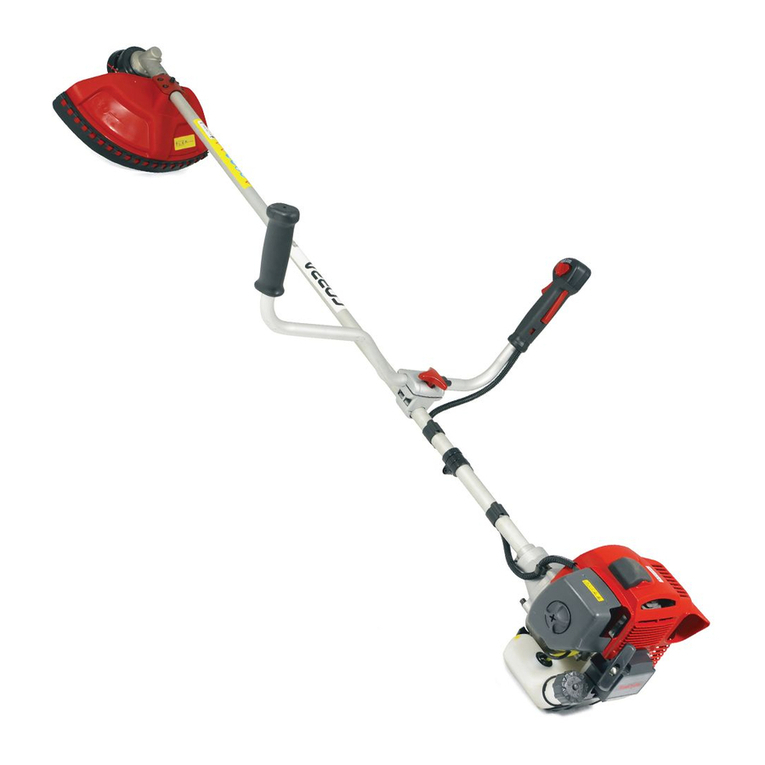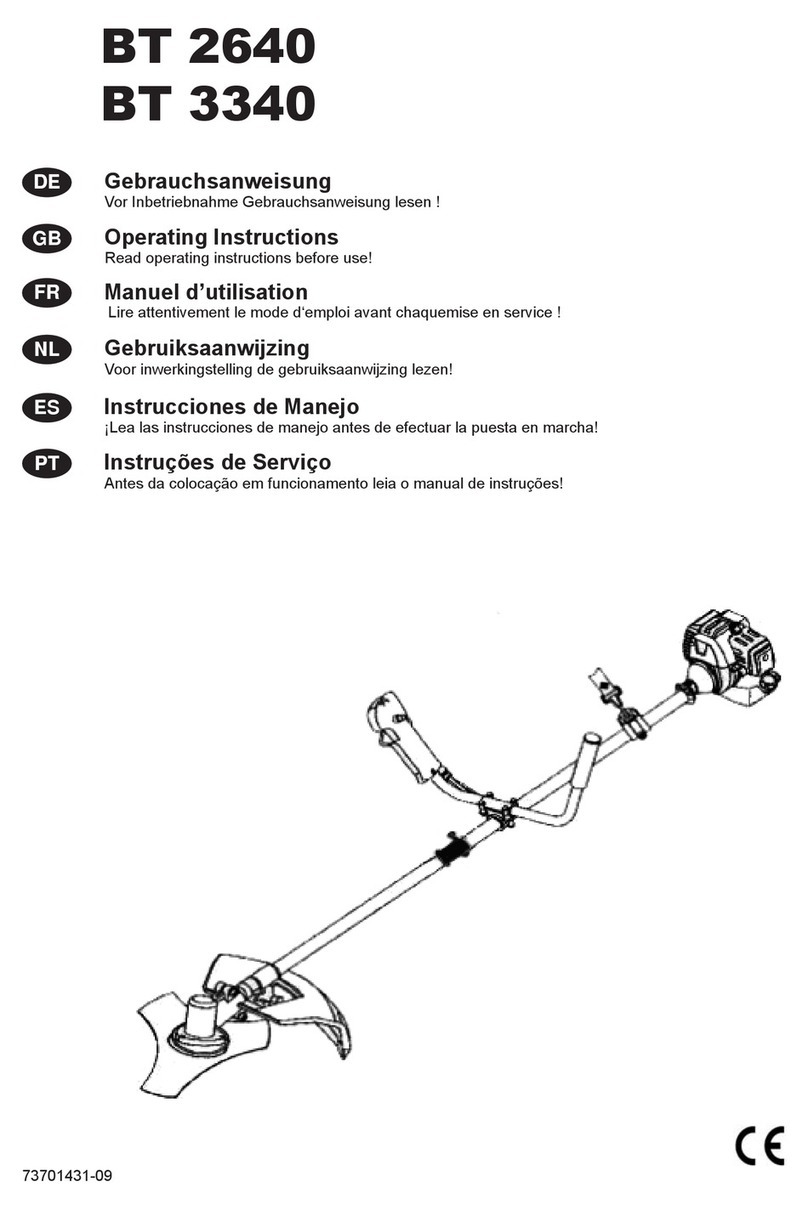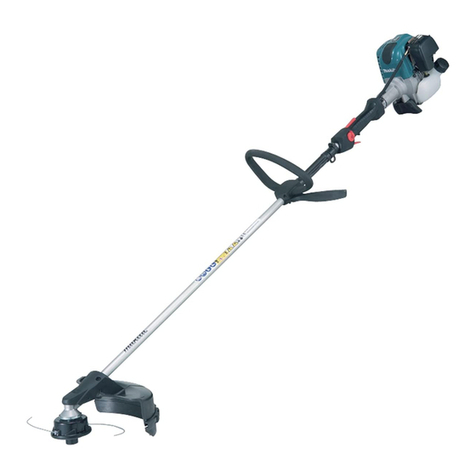Cobra BCX230C Quick reference guide

MODELS: BCX230C / BCX370CU
ASSEMBLY & OPERATING INSTRUCTIONS
BCX230C (PNB230) / BC370CU (PNB370)

CONTENTS
ENGINE
PART
BRUSH CUTTER
Attention Statements
Throughout this manual are special
attention statements.
DANGER!
DANGER!
A statement preceded by the triangular
attention symbol and the word
"WARNING"indicates a potentially
hazardous situation which, if not
avoided, COULD result in death or
serious injury!
CAUTION!
A statement preceded by the word
"CAUTION" contains information
that should be acted upon to avoid
damage to the machine.
IMPORTANT!
NOTE:
A statement preceded by the word
"IMPORTANT" is one that possesses
special significance.
A statement preceded by the word
"ONTE" contains information that is
handy to know and may make your job
easier.
A statement preceded by the triangular
attention symbol and the word
"DANGER"indicates an imminently
hazardous situation which, if not
avoided, will result in death or
serious injury!

IMPORTANT!
The information contained in these
instrucitions describes components
available at the time of publication.
While every attempt has been made to
provide the latest information about your
product, there may be some differences
between your attachment and
what is described here. We reserves
the right to make changes to products without
prior notice and without obligation to make
alterations to components
previously manufactured.
The procedures described in this manual
are intended to help you get the most from
your machine as well as to protect you and
others from harm. These procedures are
guidelines for safe operation under most
conditions, and are not intended to replace
any safety rules and/or laws that may be in
force in your area.
If you have questions regarding your power
tool, or if you do not understand something
in this manual, your local dealer will be glad
to assist you.
Safety Precautions

Operating Precautions
Never operate this tool or any
other power equipment if you are
tired, ill, or under the influence of
alcohol, drugs, or any substance
that could affect your ability or
judgement.
Keep bystanders at least 15 meters
(50 feet) away from the operating
trimmer to reduce the risk of being
struck by falling objects or thrown
debris.
read and follow this manual,
make sure anyone using the
trimmer dose likewise. Failure
to do so could result in serious
personal injury or machine
failure. Keep this manual for
future reference.
Always wear a hard hat to reduce
the risk of head injuries during
operation of this machine.In
addition, always wear eye and
hearing protection. We
recommends wearing a face
shield as additional face and eye
protection.
Wear non-slip heavy-duty gloves
to improve your grip on the
trimmer handle. Wear sturdy
footwear with nonship soles to
proivide good footing. Steel-toes
safety boots are recommended.
Were snug-fitting clothes that also
permits freedom of movement.

Operating Precautions
WARNING!
Never permit a person without training
or instruction to operate this machine.
Always make sure the cutter
attachment is properly installed and
firmly tightened before operation.
Never use a cracked or damaged
equipment, check , replace or repair before
use.
Before starting the engine, make sure the
cutter is clear of all objects.
Always stop the engine immediately and
check for damage if you strike a foreign
object or if the machine becomes tangled.
do not operate with broken or damaged
equipment.
Stop the machine immediately if it
suddenly begins to vibrate or shake.
Inspect for broken, missing or improperly
installed parts or attachments.
Keep the trimmer away from excessive
heat. Engine fuel is very flammable and
fire could lead to serious personal injury or
property damage.
Never operate this machine or other power
equipment if you are tired, ill, or under the
influence of alcohol, drugs, or any other
substance that could affect your ability of
judgement. Do not operate the trimmer
with the muffler removed.
Make sure there is always good ventilation
when operating the trimmer. Fumes from
engine exhaust can cause serious injury or
death. Never run the engine indoors!
Make sure there are no missing or loose
fasteners, and that the stop switch and
throttle controls are working properly
If a cutter should bind fast in a cut, shut off
the engine immediately.
Make sure of no fuel leaking from Fuel
tank, fuel cap, Fuel pipe and carburetor
and other parts which fuel may leak.
Repair the machine if fuel leaking, make
sure no leaking again.

2
1.
.LOCATION OF PARTS :
Warning Label
ABCD
A: WARNING
B: The Owner’s manual contains important
information on safe operation.
Read it before operating engine.
C: Gasoline is extremely flammable and
explosive.
Stop engine before refueling.
D: Exhaust gas contains carbon monoxide, an
odorless and deadly poison.
Do not run Engine in an enclosed area.
Lever type
Engine Serial Number Label
Engine Serial Number:
The engine serial number is the only means of
identifying your particular engine from others of
the same modeltype.
This engine serial number is needed by your
dealerwhen ordering parts.

7
2.. FUEL AND OIL
RECOMMENDATIONS :
WARNING
Gasoline is extremely flammable and can
be explosive under certain conditions,
creating the potential for serious burns.
Turn the ignition switch to “OFF”.
Do not smoke. Make sure the area is
well-ventilated and free from any source
of flame or sparks;
this includes any appliance with a pilot
light.
Never fill the tank completely to the top.
If the tank is filled completely to the top,
heat may cause the fuel to expand and
overflow through the vents in the tank
cap.
After refueling, make sure the tank cap is
closed securely.
If gasoline is spilled on the fuel tank,
wipe it off immediately.
NOTICE
Running on gasoline only will cause the
engine to seize. Use gasoline-oil mixture.
Kawasaki 2-stroke engine requires a gasoline-
oil mixture.
Gasoline and engine oil mixing ratio:
50:1
(Gasoline 50, 2-stroke engine Oil 1)
Pour the 2-stroke engine oil and the gasoline
into an appropriate container with the ratio
shown above, and shake it thoroughly to avoid
the separation of them. And then, pour it into the
fuel tank.
2 Stroke engine oil
20mL
Gasoline
1000mL
Container mixing fuel (Example)
Fuel Type and Octane Rating
Use clean, fresh unleaded gasoline with ethanol
volume content not more than 10% and an
octane rating equal to or higher than that shown
in the table.
Fuel Type Unleaded Gasoline
Ethanol Content E10 or less
Minimum
Octane Rating
Research Octane Number
(RON) 91
NOTICE
Do not use any fuel that contains more
ethanol or other oxygenates than
specified for E10 fuel* in this engine.
Damage to the engine and fuel system,
or engine starting and/or performance
problems may result from the use of
improper fuel.
* E10 means fuel containing up to 10% ethanol
as specif ed by European directive.
NOTICE
Do not use leaded gasoline, as this will
destroy the catalytic converter. (except
TJ53E)
NOTE
○Do not use gasoline that has been stored
longer than two month.
○To ensure proper starting at low ambient
temperatures, fresh winter grade fuel must
be used.
○If “knocking or pinging” occurs, use a different
brand of gasoline or higher octane rating.
Recommended Engine Oil
High quality 2-stroke engine oil
JASO Service Classif cation - FC class
NOTICE
Do not use 2-stroke oil that contains
Phosphorus (P), Lead (Pb) or Sulfur (S).
These elements will reduce the life and
performance of the catalytic converter.
(except TJ53E)
2.. FUEL AND OIL
RECOMMENDATIONS :
WARNING
Gasoline is extremely flammable and can
be explosive under certain conditions,
creating the potential for serious burns.
Turn the ignition switch to “OFF”.
Do not smoke. Make sure the area is
well-ventilated and free from any source
of flame or sparks;
this includes any appliance with a pilot
light.
Never fill the tank completely to the top.
If the tank is filled completely to the top,
heat may cause the fuel to expand and
overflow through the vents in the tank
cap.
After refueling, make sure the tank cap is
closed securely.
If gasoline is spilled on the fuel tank,
wipe it off immediately.
NOTICE
Running on gasoline only will cause the
engine to seize. Use gasoline-oil mixture.
Cobra 2-stroke engine requires a gasoline-oil
mixture.
Gasoline and engine oil mixing ratio:
40:1
(Petrol 40, 2-stroke engine Oil 1)
Pour the 2-stroke engine oil and the gasoline
into an appropriate container with the ratio
shown above, and shake it thoroughly to avoid
the separation of them. And then, pour it into the
fuel tank.
2 Stroke engine oil
2.5mL
Gasoline
1000mL
Container mixing fuel (Example)
Fuel Type and Octane Rating
Use clean, fresh unleaded gasoline with ethanol
volume content not more than 10% and an
octane rating equal to or higher than that shown
in the table.
Fuel Type Unleaded Gasoline
Ethanol Content E10 or less
Minimum
Octane Rating
Research Octane Number
(RON) 91
NOTICE
Do not use any fuel that contains more
ethanol or other oxygenates than
specified for E10 fuel* in this engine.
Damage to the engine and fuel system,
or engine starting and/or performance
problems may result from the use of
improper fuel.
* E10 means fuel containing up to 10% ethanol
as specif ed by European directive.
NOTE
○Do not use gasoline that has been stored
longer than two month.
○To ensure proper starting at low ambient
temperatures, fresh winter grade fuel must
be used.
○If “knocking or pinging” occurs, use a different
brand of gasoline or higher octane rating.
Recommended Engine Oil
High quality 2-stroke engine oil
JASO Service Classif cation - FC class

3.. ADJUSTMENT OF THROTTLE
CABLE :
Lock nut
Adjusting screw
Idle
screw
Throttle plate
Swivel
Stopper
● When setting the engine to equipments (bush
cutter. Etc.), adjust the throttle cable in the
following procedures.
1.. Remove the air cleaner cap. Loose the lock
nut.
2.. Turn the adjusting screw. Be sure that the
idle screw touches throttle plate at the swivel
and the play of the throttle cable is around
2 mm.
3.. Squeeze the throttle lever. Be sure that
throttle plate touches the stopper.
4. Tighten the lock nut.
4.
.STARTING :
Fuel
●Level the engine before fueling.
●Open the fuel tank cap and fill the fuel tank
with 50 : 1 gas/oil pre-mixed fuel.
● Pour slowly to avoid “spill back” and allow air
to escape from the fuel tank.
● Close the tank cap securely by turning it
clockwise as far as it will go.
WARNING
Never fill the tank so the fuel level rises
into the filler neck. If the tank is overfilled,
heat may cause the fuel to expand and
overflow through the vents in the tank
cap. After refueling, make sure the fuel
tank cap is closed securely.
If gasoline is spilled on the fuel tank,
wipe it off immediately.
DANGER
Exhaust gases contain carbon monoxide,
a colorless, odorless, poisonous gas.
Do not operate the engine in enclosed
areas. Provide adequate ventilation at
all time.
Throttle lever
Engine switch
● Turn the engine switch on the engine or the
equipment to the “I” (starting) position.
● Move the throttle lever on the equipment to the
fully CLOSED (engine idle speed) position.
Priming pump
Fuel inlet tube
Over flow tube
(transparent)
● Slowly push the priming pump several times
until the fuel comes out of the overf ow tube.
NOTE
○This engine is designed so that overflowed
fuel due to pushing a priming pump is to be
returned to the fuel tank.
○There is no fear of flooding the engine, so
push the priming pump enough times to get
the engine started.
NOTE
○Should the engine fail to start, do not try the
recoil start many times with the lift up lever to
the “STARTING” position or the choke lever
to the “CLOSED” position. This will cause
the fuel to flood into the cylinder and make
starting even more difficult. In this case, set
the lift up lever to the “RUNNING” position or
the choke lever to the “OPEN” position. And
then, repeat the starting.
○After starting, vary the engine speed a few
times, by operating the throttle lever to draw
out the remaining air in the carburetor.

4.
.STARTING continued :
●Turn the lever clockwise to switch to the
“STARTING” position.
NOTE
○If the throttle lever is squeezed or locked
at half position, the engine won’t start. Be
sure the throttle lever is in the fully CLOSED
position.
NOTE
○When the engine is already warm up, no lift
up lever or choke lever required.
Recoil starter grip
●Pull the recoil starter grip slowly to engage
the starter, then give a short, quick pull.
WARNING
Releasing the starting rope suddenly
may allow the rope to whip around and
cause injury and/or damage the recoil
starting mechanism. When starting the
engine, firmly grasp the recoil starter
grip; do not grasp the starter rope itself.
Always control the rope as it rewinds
into the housing.
Throttle lever
Lift up lever
●Squeeze the throttle lever to switch the lift up
lever to the “RUNNING” (engine idle speed)
position, and then release the throttle lever
back to fully “CLOSED” (engine idle speed)

5.
.WARMING UP :
●After starting the engine, run the engine at
the idling speed (throttle lever position is fully
CLOSED) for a few minutes.
NOTICE
Allow sufficient warm-up time to prevent
engine damage and run the engine
smoothly. The engine should be run at idle
speed for a few minutes to allow it to warm
up before applying a load. This will allow
oil to reach engine parts, and allow piston
clearance to reach design specifications.
6.
. ADJUSTING:
Idling Speed
● If the cutting blade move when the engine is
running at the idle speed, turn the idle screw
counterclockwise to decrease the engine idle
speed.
● If the engine does not run the idle speed, it
may be changed too low, turn the idle screw
clockwise to increase the engine idle speed.
The stable idle speed is shown below.
Fuel Adjustment
The carburetor has been adjusted to the
optimum fuel supply at the factory. Don’t reset
the carburetor setting.
NOTE
○If adjustment is needed, it should be
performed by your authorized dealer.
7. STOPPING :
Throttle lever
Engine switch
● Move the throttle lever on the equipment to the
fully CLOSED (engine idle speed) position,
and the engine running at idle speed.
● Turn the engine switch to the “O” (stopping)
position.
NOTICE
Suddenly stopping engine from high-
speed operation can cause engine damage.
Reduce engine speed to idle speed for one
minute before shutting engine off after
high-speed, full-load operation.
Emergency stop
● Turn the engine switch to the “O” (stopping)
position.
NOTE
○Never stop the engine by closing the choke
lever.
○Never stop the engine during operation while
running above idle speed.
● Shut off the engine and allow it to cool
before transporting or storing the unit.
● Do not put the unit on dry grass or near any
flammable object unless the engine is cold or
cooled down.

Breather
passage
Tank cap
Fuel tank
Breather
assembly
Fuel Tank Cap Service
A breather passage is incorporated in the tank
cap. If the breather passage is clogged, the
fuel will not f ow into the carburetor, causing
problems with starting or running the engine. At
the same time, make sure that the base of the
breather assembly is f tted f rmly into the groove
inside the tank cap as shown.
Air cleaner case
Element
Air cleaner cap
Air cleaner cap screw
Air Cleaner Service
Clean the air cleaner element every 20 hours.
● Remove the air cleaner cap from the air
cleaner case by removing the air cleaner cap
screw.
● Remove the element from the air cleaner
case.
● Wash the element in detergent and water,
and dry it thoroughly.
● Reinstall the element in the air cleaner case
and reinstall the air cleaner, and tighten the
screw.
NOTICE
Improper element cleaning can result in
engine damage.
Do not use compressed air to clean or
dry element. Always clean element with
an approved high flash point solvent
only. Never use gasoline.
Do not operate engine with air filter parts
removed.
Fuel Filter
Fuel Filter Service
Every 20 hours of operation
●Pull the fuel filter out from the fuel tank.
●Clean the fuel filter in a bath of high f ash-
point solvent.
●Dry the fuel filter and reinstall it into the fuel
tank.
NOTE
○If a fuel still does not flow well after the
cleaning, replace the fuel filter with new one.
WARNING
Many solvents are highly flammable
and may cause serious burns. Improper
use of solvents can result in fire or an
explosion. Do not use gasoline or low
flash-point solvents to clean the fuel
filter. Clean only in a well-ventilated area
away from sources of sparks or flame,
including any appliances with a pilot
light.
9. MAINTENANCE :

9. MAINTENANCE continued :
Electrodes
Spark plug gap
Spark Plug Service
Every 50 hours of operation
● Take the spark plug cap with fi ngers, and pull
it up.
● Remove the spark plug by using a suitable
plug wrench.
● Clean the electrodes by scraping or with a
wire brush to remove carbon deposits and
wetness.
● Inspect for cracked porcelain or other wear
and damage. Replace the spark plug with a
new one if necessary.
● Check the spark plug gap and reset it if
necessary. The gap must be between 0.6
and 0.7mm. To change the gap, bend only
side-electrode, using a spark plug tool.
● Install and tighten the spark plug to 14N·m
(1.4kgf·m).
● Fit the spark plug cap on the spark plug
securely.
● Pull up the spark plug cap lightly to make
sure of the installation of the spark plug cap.
Recommended spark plug:
NGK BPMR7A
Spark arrester
Muffler
Spark Arrester Service
Every 50 hours of operation
● Remove the spark arrester from the exhaust
hole of muffl er
● Clean deposits from the spark arrester screen
by brushing it.
● Install the spark arrester.
Carbon Removal of Engine Internal Parts
Every 50 hours of operation
These items must be performed with proper
tools.
See your authorized dealer for service.
10. STORAGE :
Lubricator Plug hole
Engine to be stored over 30 days should be
completely drained of fuel to prevent gum
deposits forming on essential carburetor parts
fuel fi lter and fuel tank.
● Clean the engine.
● Remove all the fuel from the tank and run
the engine at idling to use up the fuel in the
carburetor.
● Remove the spark plug, pour in 0.5 mL of
new 2-stroke engine oil through the plug
hole, pull the recoil starter grip several times,
and reinstall the spark plug.
● Slowly pull the recoil starter grip until
resistance is felt.
● Store the engine in a clean and dry place.
WARNING
Gasoline is a toxic substance. Dispose
of gasoline properly. Contact your
local authorities for approved disposal
methods.

WARNING!
General maintenance
Before performing any maintenance,
repair, or cleaning work on the
machine, make sure the engine and
cutting attachment are completely
stopped. Disconnect the spark plug
wire before performing service or
maintenance work.
WARNING!
WARNING!
Muffler
Non-standard parts may not operate
properly with your unit and may cause
damage and lead to personal injury.
Operating the engine without a
muffler or with a muffler that is
damaged or improperly sufficiently to
lead to hearing loss.This machine must never be operated
with a faulty or missing spark arrestor or
muffler is well secured and in good
condition, A worn or damaged muffler is
a fire hazard and may also cause
hearing loss.
SPARK PLUG
Keep the spark plug and wire
connections tight and clean.
Daily maintenance
Prior to each work day, perform the
following:
Remove all dirt and debris from the
engine, check the cooling fins and air
cleaner for clogging, and clean as
necessary. see Figure 33.
Carefully remove any accumulating of
dirt or debris from the muffler and fuel tank first build-up in these areas can lead to engine overheating , fire or premature wear.Check for loose or missing screws or
components. Make sure the cutting
attachment is free of debris and
securely fastened.
Check the entire machine for leaking
fuel or grease.
Make sure nuts, bolts and screws
(expect carburetor adjusting screws)
and tight.
Figure 33



m
7
,
/


■
■
■
■

/
o

Min.SO
•
• -1smA50)
-
m
&G
max . ,
9000 min
I
0
�Danger
& Caution
.
Note
This manual suits for next models
3
Other Cobra Brush Cutter manuals
Popular Brush Cutter manuals by other brands
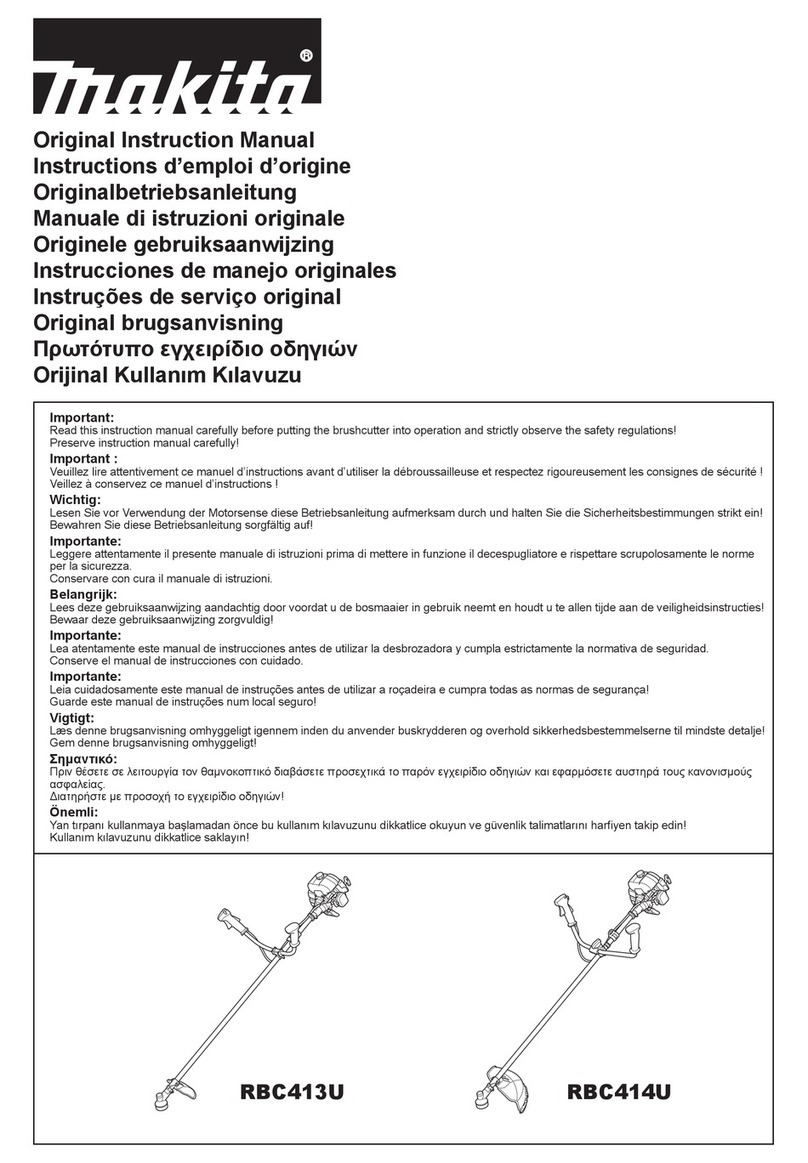
Dolmar
Dolmar RBC413U Original instruction manual

Grizzly Tools
Grizzly Tools AS 4026 Lion Translation of the original instructions for use
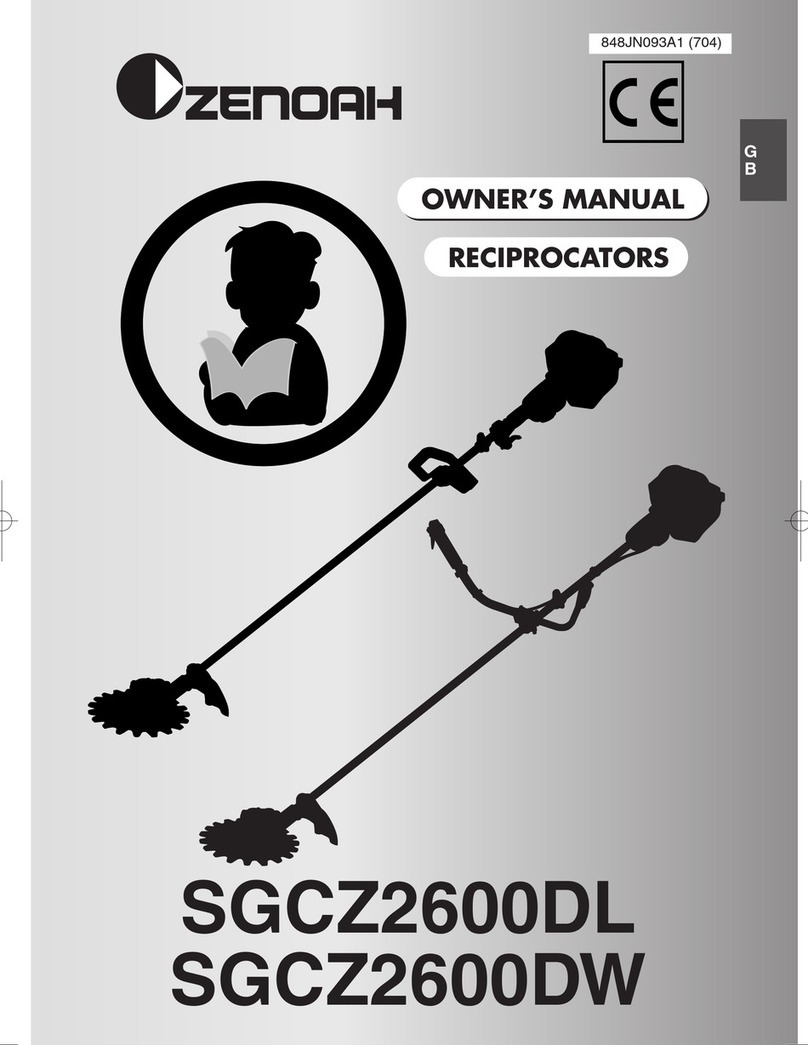
Zenoah
Zenoah SGCZ2600 owner's manual

TrimmerPlus
TrimmerPlus BC720 Operator's manual

Kasei
Kasei KZ-4000BC-PRO-2S Operator's manual

Makita
Makita EM4351UH Original instruction manual
